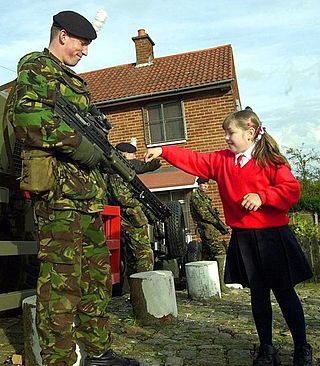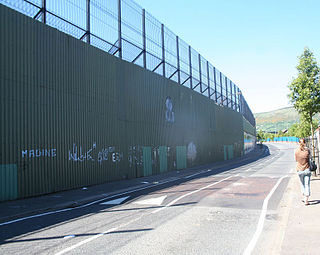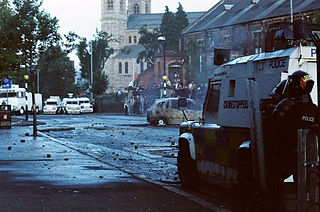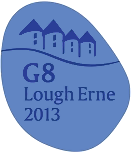Related Research Articles

The Holy Cross dispute occurred in 2001 and 2002 in the Ardoyne area of north Belfast, Northern Ireland. During the 30-year conflict known as the Troubles, Ardoyne had become segregated – Ulster Protestants and Irish Catholics lived in separate areas. This left Holy Cross, a Catholic primary school for girls, in the middle of a Protestant area. In June 2001—during the last week of school before the summer break—Protestant loyalists began picketing the school, claiming that Catholics were regularly attacking their homes and denying them access to facilities.

Ulster loyalism is a strand of Ulster unionism associated with working class Ulster Protestants in Northern Ireland. Like other unionists, loyalists support the continued existence of Northern Ireland within the United Kingdom, and oppose a united Ireland independent of the UK. Unlike other strands of unionism, loyalism has been described as an ethnic nationalism of Ulster Protestants and "a variation of British nationalism". Loyalists are often said to have a conditional loyalty to the British state so long as it defends their interests. They see themselves as loyal primarily to the Protestant British monarchy rather than to British governments and institutions, while Garret FitzGerald argued they are loyal to 'Ulster' over 'the Union'. A small minority of loyalists have called for an independent Ulster Protestant state, believing they cannot rely on British governments to support them. The term 'loyalism' is usually associated with paramilitarism.
The Northern Ireland flags issue is one that divides the population along sectarian lines. Depending on political allegiance, people identify with differing flags and symbols, some of which have, or have had, official status in Northern Ireland.
Events during the year 2001 in Northern Ireland.
This is a chronology of activities by the Continuity Irish Republican Army (CIRA), an Irish republican paramilitary group. The group started operations in 1994, after the Provisional Irish Republican Army began a ceasefire.

Interface area is the name given in Northern Ireland to areas where segregated nationalist and unionist residential areas meet. They have been defined as "the intersection of segregated and polarised working class residential zones, in areas with a strong link between territory and ethno-political identity".

Óglaigh na hÉireann is a small dissident Irish republican paramilitary group that took part in the dissident Irish Republican campaign. The organisation started carrying out attacks around 2009 and was formed after a split within the Real IRA, led by Seamus McGrane.

The 2011 Northern Ireland riots were a series of riots between 20 June 2011 and 16 July 2011, starting originally in Belfast, before spreading to other parts of Northern Ireland. They were initiated by the Ulster Volunteer Force.

From 6 to 11 July 1997 there were mass protests, fierce riots and gun battles in Irish nationalist districts of Northern Ireland. Irish nationalists/republicans, in some cases supported by the Provisional Irish Republican Army (IRA), attacked the Royal Ulster Constabulary (RUC) and British Army. The protests and violence were sparked by the decision to allow the Orange Order to march through a Catholic/nationalist neighbourhood of Portadown. Irish nationalists were outraged by the decision and by the RUC's aggressive treatment of those protesting against the march. There had been a bitter dispute over the march for many years.
During the 2012 North Belfast Riots sectarian disorder and rioting between loyalists and republicans occurred when rival parades, authorised by the Parades Commission, took place.

The 39th G8 summit was held on 17–18 June 2013, at the Lough Erne Resort, a five-star hotel and golf resort on the shore of Lough Erne in County Fermanagh, Northern Ireland. It was the sixth G8 summit to be held in the United Kingdom and the first to be held in Northern Ireland. The earlier G8 summits hosted by the United Kingdom were held in London, Birmingham (1998), and Gleneagles (2005).

On 3 December 2012, Belfast City Council voted to limit the days that the Union Flag flies from Belfast City Hall. Since 1906, the flag had been flown every day of the year. This was reduced to 18 specific days a year, the minimum requirement for UK government buildings. The move to limit the number of days was backed by the council's Irish nationalists while the Alliance Party abstained from the vote; it was opposed by the unionist councillors.
Jamie Bryson is a loyalist activist in Northern Ireland who originally attracted media attention as a leading figure in the Belfast City Hall flag protests. He is the author of four books and is the editor of Unionist Voice, a monthly unionist newsletter and online site. He also runs a consultancy business focusing on loyalist public relations, legal work and advocacy.
The 2005 Belfast riots were serious loyalist riots and civil disturbances in Belfast, Northern Ireland in September 2005. The violence broke out after the Protestant Orange Order Whiterock parade was re-routed to avoid the Irish nationalist Springfield Road area. Clashes also broke out in several towns in County Antrim. The incidents took place amid a fierce feud between members of the Ulster Volunteer Force (UVF) and Loyalist Volunteer Force (LVF), who are also thought to have orchestrated the riots.

The 2002 Short Strand clashes, also known as the siege of Short Strand, was a series of major sectarian violence and gun battles in and around the Short Strand area of east Belfast – a mainly Irish/Catholic enclave surrounded by Protestant communities. Although violence had occurred many times throughout 2002, this article deals with the worst episode in June.
The 2010 Northern Ireland riots were riots and civil disturbance in Northern Ireland in July 2010, orchestrated by Irish republicans.
Large civil disorder broke out in north Belfast, Northern Ireland on Sunday 11 November 2001. The trouble started when republicans clashed with loyalists during a Remembrance Day service. Up to 400 Protestants and Catholics were involved in rioting in the afternoon on North Queen Street.
The 2018 Derry riots were riots and civil disturbances taking place in Derry, Northern Ireland from 8 July 2018, before the Protestant Orange Order parade. It was the first 12 July parade to take place in Derry for five years. Violence broke out in the republican Bogside area in what has been called the worst in the city in "decades". The Police Service of Northern Ireland (PSNI) has blamed the New IRA group for trying to kill police officers. Riot police fired plastic baton rounds, whilst at least 70 petrol bombs have been thrown at them.
Events from the year 2021 in Northern Ireland.
A series of riots in loyalist areas of Northern Ireland began in Waterside, Derry, on 30 March 2021. After four nights of rioting in Derry, disturbances spread to south Belfast on 2 April, where a loyalist protest developed into a riot involving iron bars, bricks, masonry and petrol bombs. Following this, civil unrest spread to Newtownabbey on 3 April, where cars were hijacked and burnt, and petrol bombs were also used against police. Carrickfergus in southern County Antrim also saw serious civil unrest on the night of 4 April and morning of 5 April, where loyalists created roadblocks to keep police out of local estates and threw petrol bombs at police vehicles.
References
- ↑ Peter Taggart; Laura Smith-Spark (13 July 2013). "Extra police sent to Northern Ireland after Belfast rioting". CNN.
- 1 2 McDonald, Henry (13 July 2013). "Northern Ireland police call Belfast rioting 'shameful and disgraceful'". the Guardian.
- ↑ "106 arrested in Northern Ireland riot crackdown". 27 August 2013. Retrieved 31 July 2019– via www.rte.ie.
{{cite journal}}: Cite journal requires|journal=(help) - 1 2 Agencies (10 August 2013). "56 police hurt in Belfast riots" – via www.telegraph.co.uk.
- ↑ McDonald, Henry (9 August 2013). "Belfast loyalists riot as they attempt to prevent republican march". the Guardian.
- 1 2 "56 officers hurt in Belfast riots". BBC News. 10 August 2013.
- ↑ "'Mindless anarchy': 56 officers hurt in Belfast violence". 10 August 2013.
- ↑ Barry, Aoife (13 August 2013). "PSNI release photos of people wanted over Belfast riots and disorder". TheJournal.ie. Retrieved 31 July 2019.